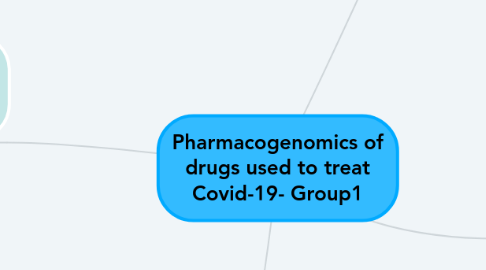
1. Types of drugs currently being used to treat COVID-19
1.1. Steroids
1.1.1. Dexamethasone
1.1.1.1. P Kim, et al. Therapy for Early COVID-19 - A Critical Need. Journal of the American Medical Association DOI: DOI:10.1001/jama.2020.22813 (2020).
1.2. Immunosuppressants
1.2.1. Tocilizumab
1.2.1.1. Samaee H, Mohsenzadegan M, Ala S, Maroufi SS, Moradimajd P. Tocilizumab for treatment patients with COVID-19: Recommended medication for novel disease [published online ahead of print, 2020 Sep 16]. Int Immunopharmacol. 2020;89(Pt A):107018. doi:10.1016/j.intimp.2020.107018
1.2.2. Anakinra
1.2.2.1. Khan NA. Anakinra for severe forms of COVID-19. Lancet Rheumatol. 2020;2(10):e586-e587. doi:10.1016/S2665-9913(20)30273-3
1.3. Monoclonal Antibodies
1.3.1. Sarilumab
1.3.1.1. Benucci M, Giannasi G, Cecchini P, et al. COVID-19 pneumonia treated with Sarilumab: A clinical series of eight patients [published online ahead of print, 2020 May 30]. J Med Virol. 2020;10.1002/jmv.26062. doi:10.1002/jmv.26062
1.4. Chemotherapy
1.4.1. Etoposide
1.4.1.1. Patel M, Dominguez E, Sacher D, et al. Etoposide as Salvage Therapy for Cytokine Storm Due to COVID-19 [published online ahead of print, 2020 Sep 12]. Chest. 2020;S0012-3692(20)34486-X. doi:10.1016/j.chest.2020.09.077
1.5. Antivirals
1.5.1. Remdesivir
1.5.1.1. P Kim, et al. Therapy for Early COVID-19 - A Critical Need. Journal of the American Medical Association DOI: DOI:10.1001/jama.2020.22813 (2020).
1.6. Alpha-2 adrenoceptor agonist
1.6.1. Precedex
1.6.1.1. Stockton J, Kyle-Sidell C. Dexmedetomidine and worsening hypoxemia in the setting of COVID-19: A case report [published online ahead of print, 2020 May 27]. Am J Emerg Med. 2020;S0735-6757(20)30425-3. doi:10.1016/j.ajem.2020.05.066
2. Metabolic enzymes that are important for the metabolism of drugs currently used to treat Covid-19
2.1. Remdesivir
2.1.1. CYP3A4
2.1.2. CYP2C8
2.1.3. CYP2D6
2.2. Dexamethasone
2.2.1. CYP3A4
2.2.2. PGP/ABCB1
2.3. Precedex
2.3.1. CYP2A6
2.4. Etoposide
2.4.1. CYP1A2
2.4.2. CYP2E1
2.4.3. CYP3A4
2.4.4. PGP/ABCB1
2.5. All information on metabolic enzymes were taken from Lexicomp
3. Genetic risk factor that could increase the risk of suffering severe Covid-19
3.1. Increased transmission
3.1.1. D614G
3.1.1.1. D614G mutation was followed by another two mutations, one silent mutation (C-to-T mutation in the nsp3 gene) and a C-to-T mutation that leads to an RNA dependent RNA polymerase
3.1.1.1.1. The three mutations is referred to as “G clade”; and it first appeared in Europe. In mid-march, a second report had revealed that the G clade started to spread and was present in 29% of the samples worldwide
3.2. Exposure to the COVID-19
3.2.1. COVID-19 induced genes
3.2.1.1. CXCL1 & CXCL2
3.2.1.1.1. Estrogen receptors are heavily involved in immunity specifically in the antiviral response
3.3. Severity and mortality cases in COVID-19
3.3.1. Expression of the TMPRSS2
3.3.2. multigene locus at 3p21.31
3.3.2.1. rs11385942 insertion–deletion GA or G variant at locus 3p21.31
3.3.2.1.1. The frequency of this GA risk allele was higher among patients who were receiving mechanical ventilation
3.3.2.2. LZTFL1
3.3.2.2.1. Participates in the immunologic synapse with antigen-presenting cells,5 such as dendritic cells (these cells prime T-lymphocyte responses)
3.3.2.2.2. CCR9, CXCR6, XCR1, and FYCO1
3.3.2.2.3. SLC6A20
3.4. References
3.4.1. Kaser, Arthur, et al. “Genetic Risk of Severe Covid-19: NEJM.” New England Journal of Medicine, 15 Oct. 2020, www.nejm.org/doi/10.1056/NEJMe2025501.
3.4.2. Abdelzaher, Hana, et al. “COVID-19 Genetic and Environmental Risk Factors: A Look at the Evidence.” Frontiers, Frontiers, 7 Sept. 2020, www.frontiersin.org/articles/10.3389/fphar.2020.579415/full.
4. Potential Adverse Events due to Pharmacogenetic Variants or DDI's
4.1. Remdesivir
4.1.1. Chloroquine
4.1.1.1. May diminish the therapeutic effect of Remdesivir
4.1.2. CYP3A4 Inducers (strong)
4.1.2.1. May decrease the serum concentration of Remdesivir
4.1.3. Hydroxychloroquine
4.1.3.1. May diminish the therapeutic effect of Remdesivir
4.2. Dexamethasone
4.2.1. Dexamethasone is a common drug, and has a long list of adverse effects and drug-drug interactions. We will only focus on some.
4.2.1.1. CYP3A4 Inducers
4.2.1.1.1. (Strong) May decrease the serum concentration of Dexamethasone. Consider avoiding this combination when treating life threatening conditions (ie: multiple myeloma)
4.2.1.2. CYP3A4 Inhibitors
4.2.1.2.1. (Strong) May decrease the metabolism of CYP3A4 Substrates
4.2.1.3. Loop Diuretics
4.2.1.3.1. Systemic Corticosteroids may enhance the hypokalemic effect of Loop Diuretics
4.2.1.4. NSAIDs (Cox-2 Selective and Nonselective)
4.2.1.4.1. Systemic corticosteroids may enhance the adverse/toxic effect of Nonselective and Cox-2 Selective NSAIDs
4.2.1.5. Thiazide and Thiazide-Like Diuretics
4.2.1.5.1. May enhance the hypokalemic effect of Thiazide and Thiazide-Like Diuretics
4.2.1.6. Vitamin K Antagonists (ie: Warfarin)
4.2.1.6.1. May enhance the anticoagulant effect of Vitamin K Antagonists.
4.2.1.7. Quinolones
4.2.1.7.1. May enhance the adverse/toxic effect of Quinolones. The risk of tendonitis and tendon rupture may be increased.
4.3. Precedex
4.3.1. Tricyclic antidepressants (TCAs) and Serotonin and norepinephrine reuptake inhibitors
4.3.1.1. May diminish the antihypertensive effect of Alpha2-Agonists
4.3.2. Antihypertensives
4.3.2.1. May enhance the hypotensive effect of Blood Pressure Lowering Agents
4.3.3. Hypotension medications
4.3.3.1. May enhance the bradycardic effect of Bradycardia-Causing Agents
4.4. Tocilizumab
4.4.1. CYP3A4 Substrates (High risk with Inducers)
4.4.1.1. Tocilizumab may decrease the serum concentration of CYP3A4 Substrates
4.4.2. Anti-TNF Agents
4.4.2.1. Tocilizumab may enhance the immunosuppressive effect of Anti-TNF Agents
4.4.3. Siponimod
4.4.3.1. Immunosuppressants may enhance the immunosuppressive effect of Siponimod
4.5. Etoposide
4.5.1. Has a long list of adverse effects and drug-drug interactions. We will only focus on some.
4.5.1.1. CYP3A4 Inducers (Strong)
4.5.1.1.1. May decrease the serum concentration of Etoposide
4.5.1.2. Vitamin K Antagonists
4.5.1.2.1. Etoposide may enhance the anticoagulant effect of Vitamin K Antagonists
4.5.1.3. P-glycoprotein/ABCB1 Inhibitors
4.5.1.3.1. May increase the serum concentration of Etoposide
4.5.1.4. Cyclosporine
4.5.1.4.1. May decrease the metabolism of Etoposide
4.6. Anakinra
4.6.1. Anti-TNF Agents
4.6.1.1. Anti-TNF Agents: May enhance the adverse/toxic effect of Anakinra
4.6.2. Leflunomide
4.6.2.1. Immunosuppressants may enhance the adverse/toxic effect of Leflunomide
4.6.2.1.1. risk for hematologic toxicity such as pancytopenia, agranulocytosis, and/or thrombocytopenia may be increased
4.6.3. Pimecrolimus
4.6.3.1. May enhance the adverse/toxic effect of Immunosuppressants
4.7. Sarilumab
4.7.1. CYP3A4 Substrates
4.7.1.1. Sarilumab may decrease the serum concentration of CYP3A4 Substrates
4.7.1.1.1. (High risk with Inducers)
4.7.2. Tacrolimus (topical)
4.7.2.1. May enhance the adverse/toxic effect of Immunosuppressants
4.7.3. Biologic DMARDs
4.7.3.1. May enhance the immunosuppressive effect of other biologic DMARDs
4.7.4. Leflunomide
4.7.4.1. Immunosuppressants may enhance the adverse/toxic effect of Leflunomide
4.7.4.1.1. risk for hematologic toxicity such as pancytopenia, agranulocytosis, and/or thrombocytopenia may be increased
4.8. Bamlanivimab
4.8.1. There are no known significant interactions.
